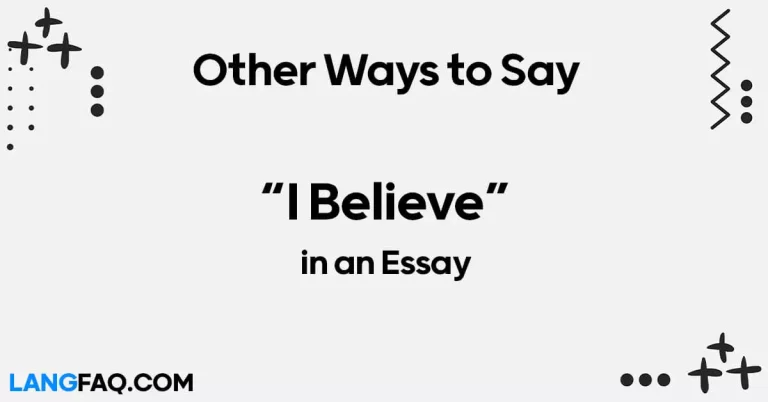Communication is the cornerstone of human interaction, and the words we choose shape our connections with others. “Dear All” is a commonly used phrase in written correspondence, but its repetitive nature can dilute its impact. Fortunately, there are numerous alternatives that can infuse your messages with freshness and vitality. In this comprehensive guide, we’ll explore 12 inventive ways to express the sentiment behind “Dear All,” empowering you to communicate with clarity, warmth, and authenticity.
12 Other Ways to Say “Dear All”
Here are 12 other ways to say “Dear All”:
- Hello Everyone
- Greetings Team
- To Whom It May Concern
- Esteemed Colleagues
- Dear Teammates
- To All Concerned
- Respected Members
- Hey Everyone
- Dear Everyone
- Good Morning/Afternoon/Evening All
- Beloved Team
- Honored Associates
Here’s a table with the meaning and examples of 12 other ways to say “Dear All”:
| Alternative Phrase | Meaning | Example |
|---|---|---|
| Hello Everyone | Friendly greeting to a group | Hello everyone! Just a quick reminder… |
| Greetings Team | Formal salutation to a group | Greetings team, we have an important… |
| To Whom It May Concern | Formal address for unknown recipients | To whom it may concern, please be… |
| Esteemed Colleagues | Acknowledgment of respect for colleagues | Esteemed colleagues, your dedication… |
| Dear Teammates | Familiar address to members of a team | Dear teammates, let’s work together… |
| To All Concerned | Addressing everyone involved or affected | To all concerned, please review… |
| Respected Members | Recognition of respect for group members | Respected members, your input… |
| Hey Everyone | Informal and inclusive greeting | Hey everyone! Just a friendly reminder… |
| Dear Everyone | Personalized address to all individuals | Dear everyone, thank you for… |
| Good Morning/Afternoon/Evening All | Time-specific greetings to a group | Good morning/afternoon/evening all, let’s… |
| Beloved Team | Affectionate address to a close-knit group | Beloved team, your efforts… |
| Honored Associates | Recognizing the value and status of group members | Honored associates, we appreciate… |
In communication, the choice of salutation sets the tone for interaction. By employing diverse alternatives to “Dear All,” individuals can tailor their greetings to suit the context and convey sincerity, respect, and inclusivity. These varied phrases offer flexibility and warmth, enriching the exchange between sender and recipient.
Is It Correct to Say “Dear All”?
Yes, “Dear All” is a common and acceptable salutation used in written communication, especially in emails and messages addressed to a group of people. It is a polite and inclusive way to address multiple recipients when their individual names are not known or when the message is intended for a broad audience.
The term “Dear” is used to convey a sense of respect and warmth, while “All” signifies that the message is directed to everyone included in the group. “Dear All” is often used in professional settings, such as workplace emails, announcements, or memos, to address colleagues, team members, or stakeholders collectively.
While “Dear All” is widely used and generally considered appropriate, it’s essential to consider the context and audience when selecting a salutation. In more formal or hierarchical environments, alternatives like “To All Concerned” or “Respected Members” may be preferred. However, in most cases, “Dear All” is a courteous and effective way to address a group of recipients in written communication.
Overall, “Dear All” is correct and widely accepted in various contexts, providing a polite and inclusive way to address multiple recipients simultaneously.
Professional Mail Example With “Dear All”
Subject: Reminder: Team Meeting Tomorrow
Dear All,
I hope this email finds you well. I wanted to send a quick reminder about our upcoming team meeting scheduled for tomorrow, [Date], at [Time] in [Location/Online Platform].
During the meeting, we will be discussing the progress of ongoing projects, upcoming deadlines, and any other important updates or announcements. Your presence and participation are crucial as we strive to ensure alignment and collaboration across teams.
Please make sure to review the agenda attached to this email and come prepared with any updates or questions you may have. If there are any specific topics you would like to address during the meeting, feel free to let me know in advance so we can include them in the agenda.
If you are unable to attend the meeting, please inform me as soon as possible so we can make necessary arrangements.
Thank you for your attention, and I look forward to our productive discussion tomorrow.
Best regards, [Your Name]
Hello Everyone
In today’s interconnected world, greetings play a crucial role in setting the tone for communication. “Hello everyone” serves as a universal salutation, welcoming individuals from diverse backgrounds and contexts. This versatile phrase strikes a balance between formality and friendliness, making it suitable for both professional and informal settings.
When to Use:
- Formal Meetings: Begin formal meetings or presentations with a polite greeting to engage the audience.
- Team Emails: Open team emails with a warm and inclusive salutation to foster collaboration and camaraderie.
- Virtual Meetings: Start virtual meetings with a friendly greeting to create a welcoming atmosphere for remote participants.
Example Sentence:
Scenario: Team Meeting
Dialogue Snippet: Facilitator: “Hello everyone! Welcome to today’s team meeting. Before we dive into our agenda, let’s take a moment to greet each other and share any updates or insights.”
Email Sample:
Subject: Weekly Team Meeting Agenda
Hello everyone,
I hope this email finds you well. Our weekly team meeting is scheduled for tomorrow at 10:00 AM. Please find attached the agenda for our discussion. Looking forward to our productive session.
Best regards, [Your Name]
Variations:
- Hey Team: Informal yet friendly alternative for addressing colleagues or teammates.
- Good Morning/Afternoon/Evening Everyone: Time-specific variations to acknowledge the time of day and set a positive tone for communication.
Related Insights:
According to Cambridge Dictionary, “hello” is a common greeting used to attract someone’s attention or to express friendly acknowledgment. It originated in the mid-19th century and has since become a widely recognized and accepted salutation in English-speaking cultures.
Pros:
- Universally recognized and appropriate for various situations.
- Sets a positive tone and fosters inclusivity.
- Easy to pronounce and understand for non-native speakers.
Cons:
- Can be perceived as overly formal in very casual settings.
- May lack personalization compared to other greetings.
Usage Tips:
- Maintain eye contact and a warm tone of voice when greeting others.
- Adapt the level of formality based on the context and relationship with the recipients.
- Use “Hello everyone” as a default greeting when unsure of the appropriate salutation.
Greetings Team
When to Use:
- Project Kickoffs: Start project meetings with a formal yet friendly greeting to inspire teamwork and motivation.
- Client Communications: Address emails or letters to clients with a respectful salutation to convey professionalism and courtesy.
- Company Announcements: Introduce company-wide announcements or updates with a polite greeting to engage employees and stakeholders.
Example Sentence:
Scenario: Client Email
Dialogue Snippet:
Sender: “Greetings team! I hope this email finds you well. We have some exciting updates to share regarding our upcoming project with [Client Name].”
Email Sample:
Subject: Project Update – [Project Name]
Greetings team,
I trust this email finds you in good spirits. I am pleased to inform you that we have made significant progress on [Project Name], and I wanted to share some updates with you. Please find attached the latest status report for your review.
Warm regards, [Your Name]
Variations:
- Dear Team: Slightly more formal alternative suitable for professional environments.
- Team Members: Neutral address that emphasizes collaboration and collective effort.
Related Insights:
According to Merriam-Webster, “greetings” refers to expressions of goodwill or courtesy, especially when meeting or communicating with others. It is often used in formal contexts to acknowledge the presence or arrival of individuals.
Pros:
- Conveys respect and professionalism.
- Establishes a sense of unity and teamwork.
- Suitable for both internal and external communications.
Cons:
- May sound impersonal if overused or not accompanied by personalized content.
- Can be perceived as too formal in very casual settings or among close-knit teams.
Usage Tips:
- Use “Greetings team” as an opening line in emails, presentations, or written communications.
- Customize the message to reflect the specific context or purpose of the communication.
- Combine with personalized elements, such as individual names or team achievements, to enhance engagement and connection.
To Whom It May Concern
In formal correspondence, addressing recipients appropriately is essential to convey professionalism and respect. “To whom it may concern” is a traditional salutation used when the specific recipient’s name is unknown or when the message is intended for a broad audience. While somewhat impersonal, this phrase remains a standard opening in business letters, cover letters, and official documents.
When to Use:
- Job Applications: Begin cover letters or letters of recommendation with this formal salutation when the recipient’s name is unknown.
- Official Inquiries: Use when initiating communication with organizations, institutions, or departments where individual contacts are not provided.
- Business Correspondence: Employ in formal letters, memos, or emails addressed to unknown recipients or multiple parties.
Example Sentence:
Scenario: Cover Letter
Dialogue Snippet:
Applicant: “To whom it may concern, I am writing to express my interest in the [Job Title] position advertised on your company website.”
Email Sample:
Subject: Inquiry Regarding Product Availability
To whom it may concern, I hope this email finds you well. I am writing to inquire about the availability of [Product Name] in your store. Could you please provide information regarding pricing and availability? Thank you for your attention to this matter.
Sincerely, [Your Name]
Variations:
- Dear Sir/Madam: A slightly more personalized alternative suitable for formal correspondence.
- Attention: [Department Name]: Directs the message to a specific department or function within an organization.
Related Insights:
According to Oxford Languages, “to whom it may concern” is a phrase used at the beginning of a formal letter or email when the identity of the recipient is unknown. It is commonly used in business and professional communication.
Pros:
- Maintains formality and professionalism in written communication.
- Suitable for addressing individuals or entities with whom there is no prior relationship.
- Provides a standard opening for official documents or inquiries.
Cons:
- May feel impersonal or outdated in certain contexts.
- Lacks the personal touch of addressing the recipient by name.
- Can come across as rigid or bureaucratic in more casual settings.
Usage Tips:
- Use “To whom it may concern” sparingly and primarily in formal or official communications.
- Whenever possible, try to research and address the recipient by name for a more personalized touch.
- Follow up with additional context or information to make the message more engaging and relevant to the recipient’s needs.
Esteemed Colleagues
When to Use:
- Professional Correspondence: Initiate formal emails, memos, or announcements addressed to colleagues within the organization.
- Collaborative Projects: Start meetings or presentations with a respectful greeting to acknowledge the expertise and contributions of team members.
- Acknowledgments: Express appreciation and recognition for colleagues’ efforts and achievements in written communication.
Example Sentence:
Scenario: Team Meeting
Dialogue Snippet:
Presenter: “Esteemed colleagues, I would like to thank each of you for your dedication and hard work on the [Project Name] initiative.”
Email Sample:
Subject: Appreciation for Team Efforts
Esteemed colleagues,
I hope this email finds you well. I wanted to take a moment to express my sincere appreciation for the exceptional work you have all done on the [Project Name] project. Your dedication, expertise, and collaboration have been instrumental in our success. Thank you for your continued commitment to excellence.
Warm regards, [Your Name]
Variations:
- Respected Colleagues: Conveys a similar sentiment of admiration and regard for colleagues’ professionalism and contributions.
- Valued Team Members: Emphasizes the importance and worth of each individual within the team or organization.
Related Insights:
According to Collins Dictionary, “esteemed” is an adjective used to describe someone who is respected and admired. When used in a salutation like “esteemed colleagues,” it signifies high regard and appreciation for the recipients’ professional standing.
Pros:
- Demonstrates respect and acknowledgment for colleagues’ expertise and contributions.
- Fosters a positive and supportive work environment by recognizing individual and collective achievements.
- Enhances morale and motivation among team members.
Cons:
- May feel overly formal in very casual or informal settings.
- Could be perceived as insincere if not accompanied by genuine appreciation or recognition.
- Requires awareness of professional hierarchies and dynamics within the organization.
Usage Tips:
- Use “Esteemed colleagues” to convey respect and appreciation for colleagues’ professionalism and expertise.
- Combine with specific examples or acknowledgments to personalize the message and highlight individual or team achievements.
- Adapt the level of formality based on the organizational culture and relationship with the recipients.
Dear Teammates
In collaborative environments, fostering a sense of camaraderie and teamwork is essential for productivity and morale. “Dear teammates” strikes a balance between familiarity and professionalism, acknowledging the shared goals and efforts of individuals working together toward a common purpose.
When to Use:
- Team Communications: Begin team emails, messages, or announcements with a warm and inclusive greeting to foster a sense of unity and belonging.
- Team-building Activities: Use in verbal communication during team meetings, workshops, or brainstorming sessions to reinforce collaboration and mutual support.
- Acknowledging Achievements: Express appreciation and recognition for team members’ contributions and accomplishments in written or verbal communication.
Example Sentence:
Scenario: Team Meeting
Dialogue Snippet:
Facilitator: “Dear teammates,I want to express my gratitude for your hard work and dedication to our shared goals. Together, we can overcome any challenges and achieve great success.”
Email Sample:
Subject: Team Appreciation
Dear teammates, I hope this email finds you well. I wanted to take a moment to express my heartfelt appreciation for each of you and the incredible work you do every day. Your dedication, creativity, and teamwork are truly inspiring, and I am grateful to be part of such an amazing team. Let’s continue to support and uplift each other as we strive for excellence.
Warm regards, [Your Name]
Variations:
- Beloved Team: Adds a touch of affection and camaraderie, emphasizing the close bond among team members.
- Team Members: Neutral alternative suitable for professional contexts where a more formal tone is desired.
Related Insights:
According to Merriam-Webster, “teammate” refers to a member of the same team or group, especially in sports. In the context of workplace communication, addressing individuals as “teammates” reinforces the collective identity and shared objectives of the group.
Pros:
- Fosters a sense of unity and belonging among team members.
- Acknowledges the shared goals and efforts of individuals working together toward a common purpose.
- Encourages collaboration, mutual support, and camaraderie within the team.
Cons:
- May feel overly casual or informal in very formal or hierarchical environments.
- Could be perceived as insincere if not accompanied by genuine appreciation or recognition.
- Requires sensitivity to individual preferences and dynamics within the team.
Usage Tips:
- Use “Dear teammates” to reinforce the sense of unity and collaboration within the team.
- Combine with specific examples or acknowledgments to personalize the message and highlight individual or collective achievements.
- Be mindful of the organizational culture and individual preferences when using casual or informal language in professional settings.
To All Concerned
When to Use:
- Official Announcements: Open formal communications, memos, or notices addressed to multiple stakeholders or parties involved in a particular matter.
- Policy Updates: Introduce changes or updates to policies, procedures, or regulations affecting a broad audience within the organization.
- Public Notices: Use in public announcements, press releases, or community notifications to address individuals or groups impacted by a specific issue or event.
Example Sentence:
Scenario: Company Memo
Dialogue Snippet:
Sender: “To all concerned, I wanted to provide an update on the upcoming changes to our company’s remote work policy.”
Email Sample:
Subject: Important Update:
Remote Work Policy To all concerned,
I hope this email finds you well. I am writing to inform you of the recent updates to our company’s remote work policy. These changes have been implemented to ensure consistency and efficiency in our operations while prioritizing the well-being and productivity of our employees. Please review the attached document for detailed information and reach out if you have any questions or concerns.
Best regards, [Your Name]
Variations:
- To Whom It May Concern: Similar formal salutation used to address unknown recipients or a broad audience in official communications.
- Attention: All Stakeholders: Directs the message to individuals or groups with a vested interest or involvement in the subject matter.
Related Insights:
According to Dictionary.com, “concerned” refers to individuals who have a vested interest, involvement, or responsibility in a particular matter or issue. Addressing recipients as “all concerned” acknowledges their relevance and connection to the subject at hand.
Pros:
- Establishes inclusivity and transparency by addressing all relevant parties or stakeholders.
- Ensures that important information or updates reach the intended audience in a timely and organized manner.
- Demonstrates professionalism and accountability in official communications.
Cons:
- May feel impersonal or generic if not accompanied by specific context or information relevant to the recipients.
- Could be perceived as bureaucratic or formalistic in more casual or interpersonal settings.
- Requires clarity and precision in conveying the purpose and relevance of the communication to all concerned parties.
Usage Tips:
- Use “To all concerned” as a formal and inclusive salutation in official communications addressed to multiple parties or stakeholders.
- Provide relevant context or information to ensure recipients understand the purpose and relevance of the communication to them.
- Follow up with additional details or resources as needed to address any questions or concerns raised by the recipients.
Respected Members
In professional settings, acknowledging the expertise and contributions of colleagues is essential for fostering mutual respect and collaboration. “Respected members” is a formal yet cordial salutation that recognizes the value and standing of individuals within a group or organization.
When to Use:
- Committee Meetings: Begin meetings or discussions with a formal greeting to honor the expertise and experience of committee members.
- Professional Associations: Address communications or announcements to members of professional organizations or societies to convey respect and appreciation.
- Board of Directors: Use in correspondence or official communications addressed to members of the board to acknowledge their leadership and expertise.
Example Sentence:
Scenario: Committee Meeting
Dialogue Snippet:
Chairperson: “Respected members, I would like to welcome you all to today’s committee meeting. Your insights and expertise are invaluable as we discuss the agenda items.”
Email Sample:
Subject: Invitation to Annual General Meeting
Respected members,
I hope this email finds you well. On behalf of the board of directors, I am pleased to extend an invitation to our upcoming Annual General Meeting. Your presence and participation are crucial as we review the past year’s achievements and chart the course for the future. Please find attached the agenda and RSVP at your earliest convenience.
Best regards, [Your Name]
Variations:
- Esteemed Members: Conveys a similar sentiment of admiration and regard for the recipients’ professionalism and expertise.
- Honored Colleagues: Adds a touch of reverence and appreciation, emphasizing the esteemed status of individuals within the group.
Related Insights:
According to Lexico, “respected” is an adjective used to describe someone who is admired and esteemed by others for their qualities, achievements, or position. Addressing individuals as “respected members” acknowledges their standing and contributions within a particular context or group.
Pros:
- Demonstrates respect and appreciation for the expertise and experience of individuals within the group.
- Sets a formal yet cordial tone for professional interactions and communications.
- Reinforces the sense of camaraderie and mutual respect among colleagues or peers.
Cons:
- May feel overly formal or ceremonial in very casual or informal settings.
- Could be perceived as insincere if not accompanied by genuine appreciation or recognition.
- Requires awareness of professional hierarchies and dynamics within the organization or group.
Usage Tips:
- Use “Respected members” to convey esteem and appreciation for the expertise and contributions of individuals within a professional context.
- Combine with specific acknowledgments or expressions of gratitude to personalize the message and highlight individual or collective achievements.
- Be mindful of the appropriate level of formality based on the organizational culture and relationship with the recipients.
Hey Everyone
When to Use:
- Informal Meetings: Start casual team meetings, brainstorming sessions, or social gatherings with a friendly and inclusive greeting to set a relaxed tone.
- Team Chats: Use in informal group chats or instant messaging platforms to address colleagues or teammates in a casual and approachable manner.
- Social Events: Begin informal gatherings or social outings with a casual and friendly salutation to welcome participants and foster a sense of camaraderie.
Example Sentence:
Scenario: Casual Team Meeting
Dialogue Snippet:
Team Leader: “Hey everyone! Thanks for joining today’s meeting. Let’s dive into our agenda and see how we can collaborate on upcoming projects.”
Email Sample:
Subject: Pizza Party Reminder
Hey everyone, Just a quick reminder about our pizza party tomorrow evening at 6:00 PM. Don’t forget to RSVP and let us know your preferred toppings. Looking forward to a fun and delicious evening together!
Best, [Your Name]
Variations:
- Hello Team: Slightly more formal alternative for addressing colleagues or teammates in informal settings.
- Hi Everyone: Casual yet polite greeting suitable for various social or professional contexts.
Related Insights:
According to Macmillan Dictionary, “hey” is an informal greeting used to attract someone’s attention or to express surprise, joy, or other emotions. Addressing a group as “everyone” acknowledges the collective presence and participation of individuals in the conversation or event.
Pros:
- Sets a friendly and inclusive tone for informal interactions and gatherings.
- Encourages open communication and active participation among colleagues or peers.
- Creates a relaxed and welcoming atmosphere conducive to creativity and collaboration.
Cons:
- May feel overly casual or informal in very formal or professional settings.
- Could be perceived as disrespectful if used inappropriately or excessively.
- Requires sensitivity to individual preferences and organizational norms regarding language and communication style.
Usage Tips:
- Use “Hey everyone” to initiate informal interactions or gatherings among colleagues or peers.
- Combine with specific details or invitations to personalize the message and engage participants.
- Be mindful of the context and audience when using informal language in professional or social settings.
Dear Everyone
In inclusive environments where individuals come together for a common purpose, addressing everyone with warmth and respect is paramount. “Dear everyone” offers a personalized touch while encompassing the collective audience, making it suitable for a wide range of contexts, from professional settings to social gatherings.
When to Use:
- Group Emails: Begin emails addressed to multiple recipients with a friendly and inclusive greeting to ensure everyone feels valued and included.
- Team Meetings: Start team meetings or discussions with a warm and inclusive salutation to foster a sense of belonging and unity.
- Community Events: Address participants or attendees at community events, workshops, or seminars with a welcoming and inclusive greeting to set a positive tone.
Example Sentence:
Scenario: Community Event
Dialogue Snippet: Facilitator: “Dear everyone, welcome to today’s community workshop on sustainable living. We’re thrilled to have such a diverse group of participants joining us today.”
Email Sample:
Subject: Invitation to Volunteer Appreciation Event
Dear everyone,
I hope this email finds you well. On behalf of the organizing committee, I would like to extend a heartfelt invitation to our upcoming Volunteer Appreciation Event. Your dedication and contributions have been instrumental in our community’s success, and we look forward to celebrating together. Please RSVP by [date] to confirm your attendance.
Warm regards, [Your Name]
Variations:
- Hello Everyone: Neutral and inclusive alternative suitable for various contexts, from professional to informal settings.
- Greetings Everyone: Formal yet friendly greeting that acknowledges the presence and participation of all individuals in the group.
Related Insights:
According to Merriam-Webster, “dear” is an adjective used to express affection or regard for someone. When combined with “everyone,” it signifies warmth and appreciation for the collective audience or group of individuals.
Pros:
- Conveys warmth, inclusivity, and respect for all individuals within the group.
- Sets a positive tone and fosters a sense of belonging and unity among participants.
- Suitable for various contexts, from professional to social settings, where inclusivity and engagement are valued.
Cons:
- May feel overly formal or impersonal if not accompanied by genuine warmth or sincerity.
- Could be perceived as insincere if used inappropriately or excessively.
- Requires awareness of individual preferences and cultural norms regarding greetings and communication styles.
Usage Tips:
- Use “Dear everyone” to address a diverse group of individuals with warmth and inclusivity.
- Combine with personalized messages or acknowledgments to enhance engagement and connection with the audience.
- Be mindful of the tone and context when using inclusive language in professional or social settings to ensure it aligns with the intended message and audience.
Good Morning/Afternoon/Evening All
When to Use:
- Time-specific Greetings: Begin communications or interactions with colleagues, peers, or participants by acknowledging the time of day and wishing them well.
- Team Check-ins: Use in morning huddles, afternoon meetings, or evening wrap-ups to set the tone and agenda for the day’s activities or reflections.
- Virtual Meetings: Start virtual meetings or webinars with a time-specific greeting to create a sense of presence and connection among remote participants.
Example Sentence:
Scenario: Virtual Meeting
Dialogue Snippet: Host: “Good morning all, and welcome to today’s virtual training session. I hope you’re all feeling energized and ready to dive into our topics for the day.”
Email Sample:
Subject: Weekly Team Update – [Date]
Good afternoon all,
I trust this email finds you well. As we approach the end of another productive week, I wanted to provide a brief update on our team’s progress and upcoming priorities. Please review the attached document for details, and don’t hesitate to reach out if you have any questions or concerns.
Best regards, [Your Name]
Variations:
- Morning/Afternoon/Evening Everyone: Simplified versions of the greeting tailored to specific times of the day.
- Happy [Day of the Week]: Adds a touch of positivity and anticipation for the day ahead, such as “Happy Monday” or “Happy Friday.”
Related Insights:
According to Collins Dictionary, “good morning,” “good afternoon,” and “good evening” are greetings used to say hello to someone during the morning, afternoon, or evening, respectively. These time-specific greetings acknowledge the time of day and convey well-wishes for the recipient.
Pros:
- Sets a friendly and welcoming tone by acknowledging the time of day and wishing recipients well.
- Creates a sense of presence and connection, particularly in virtual or remote interactions.
- Provides an opportunity for informal check-ins and reflections on the day’s activities or upcoming priorities.
Cons:
- Requires awareness of the appropriate time zone and cultural norms when addressing individuals in different locations.
- May feel repetitive or unnecessary in very casual or informal settings.
- Can be perceived as insincere if used without genuine warmth or consideration for the recipient’s well-being.
Usage Tips:
- Use “Good morning/afternoon/evening all” to acknowledge the time of day and convey well-wishes to colleagues, peers, or participants.
- Combine with brief updates or agenda items to set the tone and agenda for the interaction or communication.
- Be mindful of individual preferences and cultural sensitivities regarding time-specific greetings, particularly in diverse or international settings.
Beloved Team
In environments where trust, camaraderie, and mutual support are cherished, addressing colleagues with affection and warmth can strengthen bonds and foster a sense of belonging. “Beloved team” goes beyond the conventional salutations, infusing interactions with a heartfelt appreciation for the close-knit relationships and shared experiences within the group.
When to Use:
- Team Celebrations: Begin celebrations, team-building activities, or appreciation events with a heartfelt greeting to express gratitude and admiration for the team’s accomplishments.
- Special Occasions: Use on birthdays, work anniversaries, or other milestones to celebrate individual and collective achievements and reinforce the bonds of friendship.
- Expressions of Gratitude: Employ in written or verbal communications to convey appreciation and love for the support, collaboration, and camaraderie shared among team members.
Example Sentence:
Scenario: Team Appreciation Event
Dialogue Snippet:
Team Leader: “Beloved team, as we gather here tonight to celebrate our successes and milestones, I am filled with gratitude for each of you and the incredible journey we’ve embarked on together.”
Email Sample:
Subject: A Message of Gratitude
My beloved team,
As we reflect on another year of challenges, triumphs, and growth, I want to take a moment to express my deepest gratitude for each of you. Your dedication, resilience, and unwavering support have been the cornerstone of our success, and I am honored to be part of such an extraordinary team. Here’s to many more milestones and memories together.
With heartfelt appreciation, [Your Name]
Variations:
- Dear Friends and Colleagues: Combines warmth and familiarity to address both professional and personal relationships within the team.
- Cherished Teammates: Conveys a sense of endearment and admiration for the close bonds and shared experiences among team members.
Related Insights:
According to Vocabulary.com, “beloved” is an adjective used to describe something or someone dearly loved and cherished. When applied to a team or group, it signifies the deep affection and appreciation for the individuals and relationships within the collective.
Pros:
- Fosters a sense of emotional connection and belonging among team members.
- Acknowledges the value and significance of individual and collective contributions to the team’s success.
- Creates a warm and inviting atmosphere conducive to open communication, trust, and collaboration.
Cons:
- May feel overly sentimental or exaggerated if not accompanied by genuine affection or appreciation.
- Could be perceived as insincere if used inappropriately or excessively.
- Requires a strong foundation of trust and camaraderie within the team to be received positively.
Usage Tips:
- Use “Beloved team” to express heartfelt appreciation and admiration for the close bonds and shared experiences within the group.
- Combine with personal anecdotes, memories, or expressions of gratitude to strengthen emotional connections and foster a sense of belonging.
- Be mindful of individual preferences and cultural norms regarding expressions of affection and endearment in professional settings.
Honored Associates
When to Use:
- Professional Acknowledgments: Begin formal presentations, speeches, or acknowledgments with a respectful greeting to recognize the expertise, contributions, and accomplishments of colleagues or peers.
- Professional Networks: Address members of professional associations, networks, or societies with a formal and dignified salutation to convey respect and appreciation for their standing and achievements.
- Business Collaborations: Use in written communications or meetings with partners, clients, or stakeholders to express esteem and gratitude for their collaboration, expertise, and support.
Example Sentence:
Scenario: Keynote Address
Dialogue Snippet: Speaker: “Honored associates, as we gather here today to discuss the future of our industry, I am humbled by the collective expertise and dedication in this room.”
Email Sample:
Subject: Invitation to Industry Summit
Honored associates,
I trust this email finds you well. On behalf of our organization, I am pleased to extend an invitation to our upcoming Industry Summit. Your presence and participation are invaluable as we explore emerging trends, challenges, and opportunities in our field. Please RSVP at your earliest convenience, and I look forward to our fruitful discussions.
Warm regards, [Your Name]
Variations:
- Respected Partners: Emphasizes the collaborative relationship and mutual respect between parties involved in a professional endeavor.
- Esteemed Colleagues: Conveys admiration and regard for the expertise and contributions of individuals within the professional community or organization.
Related Insights:
According to Oxford Languages, “honored” is an adjective used to describe someone who is respected and admired for their qualities, achievements, or position. When applied to associates or colleagues, it signifies the esteem and appreciation for their standing and contributions within a professional context.
Pros:
- Demonstrates respect, admiration, and appreciation for the expertise, accomplishments, and contributions of colleagues or peers.
- Sets a formal and dignified tone for professional interactions and communications.
- Enhances professional relationships and fosters goodwill among individuals and organizations.
Cons:
- May feel overly formal or ceremonial in very casual or informal settings.
- Could be perceived as insincere if not accompanied by genuine admiration or appreciation.
- Requires awareness of professional hierarchies, cultural sensitivities, and individual preferences when addressing associates or colleagues.
Usage Tips:
- Use “Honored associates” to convey respect, admiration, and appreciation for the expertise, accomplishments, and contributions of colleagues or peers.
- Combine with specific acknowledgments, accolades, or expressions of gratitude to personalize the message and strengthen professional relationships.
- Be mindful of the appropriate level of formality and cultural norms when addressing associates or colleagues in different professional settings.
FAQs (Frequently Asked Questions)
Can I use these alternatives in both formal and informal settings?
Absolutely! The versatility of these phrases allows them to adapt to various communication contexts. Whether you’re addressing colleagues, clients, or friends, you can tailor your greeting to suit the tone and audience.
Are there any cultural considerations to keep in mind when using these alternatives?
While these phrases are widely accepted in English-speaking environments, it’s essential to consider cultural norms and preferences in diverse settings. When in doubt, err on the side of formality and respect.
How can I remember to use these alternatives consistently in my communications?
Integrate these phrases into your vocabulary by practicing them regularly in written and verbal communication. You can also create templates or shortcuts in your email software to streamline the process.
Will using these alternatives improve the effectiveness of my messages?
Absolutely! By incorporating fresh and varied language into your communications, you can capture the attention of your audience and foster stronger connections. Experiment with different phrases to discover what resonates best with your recipients.
Can I mix and match these alternatives to create unique greetings?
Certainly! Feel free to combine elements from different phrases to craft personalized greetings that reflect your style and personality. The goal is to communicate authentically while engaging your audience effectively.
How can I encourage others to adopt these alternatives in their communications?
Lead by example and demonstrate the impact of using diverse language in your own messages. Share the benefits of these alternatives with your colleagues and encourage open dialogue about effective communication strategies.
Conclusion
In conclusion, mastering the art of communication involves more than just choosing the right words—it’s about fostering meaningful connections and building rapport with your audience. By exploring alternative phrases to “Dear All,” you can inject creativity and authenticity into your messages, leaving a lasting impression on your recipients. Whether you’re addressing colleagues, clients, or friends, the power of language lies in its ability to convey warmth, respect, and camaraderie. So why settle for the ordinary when you can elevate your communication skills with these 12 inventive alternatives? Start incorporating them into your messages today and watch your connections flourish.







